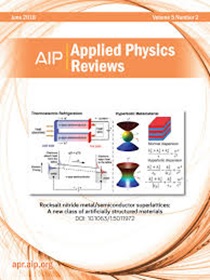利用多体量子蒙特卡罗方法改进二维材料的性能预测
IF 11.6
1区 物理与天体物理
Q1 PHYSICS, APPLIED
引用次数: 0
摘要
在过去的二十年里,二维材料领域发展迅猛。二维材料可用于各种下一代光电、自旋电子、清洁能源和量子计算应用。这些二维结构通常是从层状范德华材料中剥离出来的,具有高度不均匀的电子密度,并且可以具有短期和长期的电子相关性。二维材料的复杂性使得使用密度泛函理论(DFT)等标准平均场电子结构方法进行研究具有挑战性,这些方法依赖于未知交换相关泛函的近似值。为了克服DFT的局限性,可以利用扩散蒙特卡罗(DMC)等高精度的多体电子结构方法。在过去的十年中,DMC已被用于计算精确的磁性、电子、激子和拓扑性质,以及精确捕获二维材料的层间相互作用、内聚力和吸附能量。该方法已应用于广泛关注的二维体系,包括石墨烯、磷烯、MoS2、CrI3、VSe2、GaSe、GeSe、硼罗芬等。在这篇综述文章中,我们重点介绍了DMC最近在二维系统中的一些成功应用,以改进超出标准DFT的性能预测。本文章由计算机程序翻译,如有差异,请以英文原文为准。
Toward improved property prediction of 2D materials using many-body quantum Monte Carlo methods
The field of 2D materials has grown dramatically in the past two decades. 2D materials can be utilized for a variety of next-generation optoelectronic, spintronic, clean energy, and quantum computing applications. These 2D structures, which are often exfoliated from layered van der Waals materials, possess highly inhomogeneous electron densities and can possess short- and long-range electron correlations. The complexities of 2D materials make them challenging to study with standard mean-field electronic structure methods such as density functional theory (DFT), which relies on approximations for the unknown exchange-correlation functional. To overcome the limitations of DFT, highly accurate many-body electronic structure approaches such as diffusion Monte Carlo (DMC) can be utilized. In the past decade, DMC has been used to calculate accurate magnetic, electronic, excitonic, and topological properties in addition to accurately capturing interlayer interactions and cohesion and adsorption energetics of 2D materials. This approach has been applied to 2D systems of wide interest, including graphene, phosphorene, MoS2, CrI3, VSe2, GaSe, GeSe, borophene, and several others. In this review article, we highlight some successful recent applications of DMC to 2D systems for improved property predictions beyond standard DFT.
求助全文
通过发布文献求助,成功后即可免费获取论文全文。
去求助
来源期刊

Applied physics reviews
PHYSICS, APPLIED-
CiteScore
22.50
自引率
2.00%
发文量
113
审稿时长
2 months
期刊介绍:
Applied Physics Reviews (APR) is a journal featuring articles on critical topics in experimental or theoretical research in applied physics and applications of physics to other scientific and engineering branches. The publication includes two main types of articles:
Original Research: These articles report on high-quality, novel research studies that are of significant interest to the applied physics community.
Reviews: Review articles in APR can either be authoritative and comprehensive assessments of established areas of applied physics or short, timely reviews of recent advances in established fields or emerging areas of applied physics.
 求助内容:
求助内容: 应助结果提醒方式:
应助结果提醒方式:


